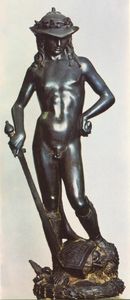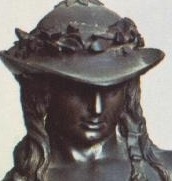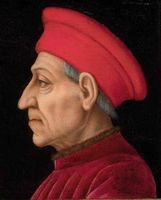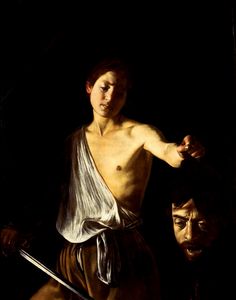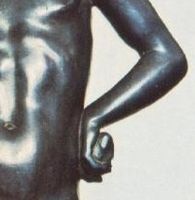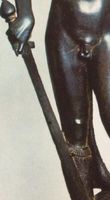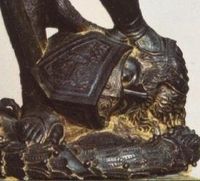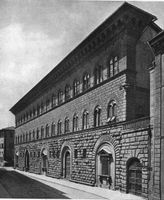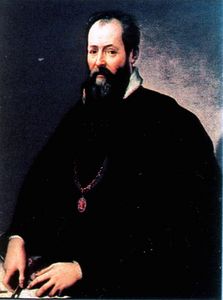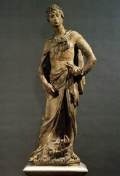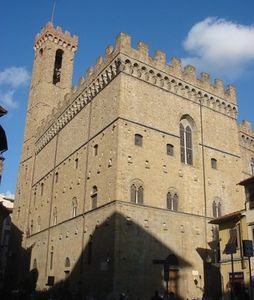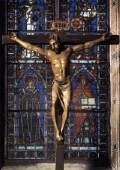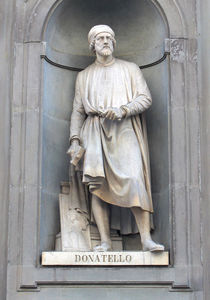David
- Date of Creation:
- circa 1430
- Height (cm):
- 158.00
- Medium:
- Other
- Subject:
- Figure
- Created By:
- Current Location:
- Florence, Italy
- Displayed at:
- Museo Nazionale del Bargello
David Story / Theme
The story of David, a biblical hero who triumphed over his enemy under extraordinary circumstances, is very inspiring and has been the subject of numerous works of art. Statues, paintings, frescoes and all forms of literature have explored the heroism and youthful courage that David embodied as he faced the Philistine giant, Goliath.
Despite its distance from the Gothic period and somewhat waning devotion at the time to the Catholic Church, religion and religious figures remained prominent in all works of art, probably because churches were still being built and still needed to be decorated.
Donatello was not religious; in fact, he was openly homosexual, which was in direct conflict with both the religious and secular laws of the period. However, this did not stop him from sculpting his magnificent bronze masterpiece.
Found in the book of Samuel, the story of David is thus: in a battle between the Philistines and Israelites the best Philistine warrior, Goliath, persistently challenges the Israelites to send their best warrior to fight him. The man-to-man matchup would decide the outcome of the battle and the winner's side would be declared victorious.
When all of the seasoned Israelite soldiers, terrified by the giant's size and strength, refused to fight him, David, a shepherd boy who had no experience in battle, stepped forward and offered to fight. He refused armor and weapons and faced the giant clad in only a tunic and armed with a slingshot.
He knocked the giant to the ground with one shot, and then grabbed Goliath's sword and cut off his head. In effect, David saved the Israelites from annihilation.
No records exist regarding the commission or production of Donatello's David. Nothing is known about its origins; the earliest known reference to the statue was in 1469, when it was described as being in the center of the courtyard at the Medici Palace. However, most scholars assume that David was commissioned by Cosimo de Medici, Donatello's lifelong patron and friend.
David Inspirations
No records survive from the time of the David's creation to shed any light on why or for whom it was created. Scholars speculate, with probable accuracy, that the work was commissioned by Cosimo de Medici, a close friend of Donatello's and a member of the wealthy art patron family of Florence.
It is well documented that Donatello was not religious, so the inspiration for David likely came from another source; perhaps it was simply Donatello's desire to craft a lithe, graceful youth in a stance of celebration and triumph.
Donatello may also have wanted to experiment with bronze; David was the first freestanding bronze statue in the Western art world and met with much praise and acclaim.
Regardless of the source of inspiration for David, the piece was an instant success and marked the beginning of Donatello's extraordinary career.
David Analysis
There are so many striking and unique parts to Donatello's David; nearly everything about the statue - from the material from which it was sculpted to the subject's "clothing" - was mold-breaking in some way. Scholars and artists have studied David for centuries in an attempt to both learn more about the man behind it and to more fully discern its meaning.
Composition:
It's clear that there are no accidental compositional elements to David. Donatello's masterpiece is obviously a work that sprang from a crystal-clear vision and months of meticulous construction and fastidious planning.
David's pose is graceful and even effeminate; his right hip is thrust slightly outward, his left hand on left hip, in a stance of undeniable femininity. Some scholars claim that if not for the presence of male genitalia, David could be taken for a woman.
Adding to the feminine overtones is the absurdly oversized sword David is gripping in his left hand, his "helmet" (which more closely resembles a French lady's hat), and the delicate curves that make up his thighs and torso.
His expression suggests purity, youthfulness and innocence with just a hint of enigma and mischief.
Perspective:
David's freestanding construction allows the viewer to see it from every possible angle and take note of all the nuances and details so painstakingly applied.
Interpretation:
At David's feet is the head of the slain giant, Goliath, over which David's left foot is positioned rather languidly, almost carelessly. His left knee is bent demurely to the right in a youthful gesture of diffidence.
Many scholars have noted with interest the way a curl of Goliath's beard has found its way between two of David's sandal-clad toes. This slightly disturbing facet of the sculpture has various interpretations. One is that, as Donatello was openly homosexual, the beard-and-foot interaction was meant to convey his sexuality.
Another interpretation suggests that it was meant as commentary on "homosocial" values: in Florence during this period it was common for men to believe they could achieve true love only with other men. Perhaps Donatello was tactfully expressing, through David's foot and Goliath's beard, his own opinion on the subject.
David is described in the Bible as a perfect, beautiful youth. Donatello's rendering of the heroic shepherd boy captures this youthful beauty perfectly, if somewhat effeminately. The sculpture has provided critics and scholars throughout the centuries with fodder for analysis and conjecture.
David Critical Reception
Initial reception:
While scholars may disagree about David's origins, one thing they do wholeheartedly agree on is the extraordinary success it enjoyed immediately upon completion.
Despite David's apparently controversial composition (it has been likened to a modern-day "shemale"), there is no record of public outcry or indignation regarding the statue. It was placed in the town hall of Florence in the 1490s, very strong evidence that it was not viewed as lewd or outrageous.
Most likely commissioned by Cosimo de Medici, David first was situated in the courtyard of the Medici Palace and later moved to various places of honor and museums around Italy. It was a hit during its time for its unique freestanding construction and bronze composition.
After death:
Although the art world remains united in its evaluation of David as a fascinating, brilliantly-crafted specimen, opinion and interpretation have been widely divergent over the centuries.
In Donatello's life and the century thereafter, the statue was mainly applauded by the art world and laypeople alike. Opinions began to vary in the sixteenth century, however, when the Herald of the Signoria (government body) commented that David "is not a perfect figure because its right leg is tasteless". This comment is open to interpretation, but most scholars conclude that there seemed to be something unsettling about the statue (perhaps its patent femininity).
In the middle of the sixteenth century, chronicler Vasari described David as strikingly naturalistic; so naturalistic, in fact, that he must have been made from life (i. e. Donatello must have used a model). Interpretation among twentieth- and twenty-first century scholars has been varied, to say the least. The past hundred years or so of David's life have been marked by considerable controversy over the sculpture's proper interpretation.
In any event, David remains a cornerstone of Western art and a timeless piece of art history.
David Related Sculptures
David Locations Through Time - Notable Sales
There is no documentary evidence of David's initial commission and location, but it was probably placed, at least in the beginning, in the courtyard of the Medici Palace. Cosimo de Medici was a lifelong friend and patron of Donatello and it is likely that the commissioned the work (though there is no proof of this).
After the Medici family was exiled from Florence in 1494, the statue was moved to the courtyard of the Palazzo della Signoria (where it joined Michelangelo's marble David). It remained in the Palazzo della Signoria until the seventeenth century, when it was relocated to the Pitti Palace.
The eighteenth century saw it move to the famous Galleria degli Uffizi in 1777. Finally, in 1865, Donatello's masterpiece was moved to the Museo Nazionale del Bargello in Florence and can still be found there today.
David Artist
Donato di Niccolo di Betto Bardi, nicknamed Donatello by friends and family, was a Florentine sculptor born to a woolcomber named Nicolo di Betto Bardi. He was briefly apprenticed to Renaissance master Lorenzo Ghiberti but quickly struck out on his own and found immeasurable fame and success sculpting for churches and private patrons through Italy.
Donatello worked alongside the towering architectural genius of Brunelleschi and spent many years of his life in both Padua and Rome, furthering his knowledge of sculpture and enhancing his reputation.
Donatello is responsible for merging the worlds of classicism and the Renaissance and produced some of the most important sculptures in the history of Western art, such as David, and in doing so he heavily influenced many of the best-known Renaissance masters.
Donatello enjoyed a thriving, busy, prosperous career until he died in 1466 at the age of 80. He was buried beside his lifelong friend and patron, Cosimo de Medici.
David Art Period
Donatello sculpted David at the beginning of the Florentine Renaissance, so the statue is typically categorized as Early Renaissance art. At the time of its production the art world was crawling out of Gothicism at a snail's pace; Giotto had urged it along somewhat with his revolutionary naturalism and humanism in the fourteenth century, but discernible change was still nearly a hundred years away.
While his contemporaries stuck mostly to Gothicism, with a few innovations, Donatello studied the classic works of Greece and Rome. Out of his studies and ruminations came David - part of Donatello's gap-bridging efforts between the classical world and the Renaissance.
During the Early Renaissance, Donatello was surrounded by many famous and talented artists, among them Brunelleschi, Ghiberti, Masaccio, Jacopo della Quercia and Michelozzo. Along with their contemporaries, these artists gave birth to the High Renaissance and the genius of Michelangelo, da Vinci and many others.
David Bibliography
To find out more about Donatello please choose from the following recommended sources.
• Bennett, Bonnie A. & Wilkins, David G. Donatello. Moyer Bell Limited, 1985
• Janson, H. W. Sculpture of Donatello. Princeton University Press, 1979
• Lightbown, R. W. Donatello and Michelozzo: Artistic Partnership and Its Patrons in the Early Renaissance. Harvey Miller Publishers, 1980
• Lubbock, Jules. Storytelling in Christian Art from Giotto to Donatello. Yale University Press, 2006
• Poeschke, Joachim. Donatello and His World: Sculpture of the Italian Renaissance. Harry N Abrams, 1993
• Pope-Hennessy, John Wyndham. Donatello: Sculptor. Abbeville Press, 1993
• Rea, Hope. Donatello. Forgotten Books, 2010
• Scott, Leader. Ghiberti and Donatello: With Other Early Italian Sculptors. Bibliolife, 2008

